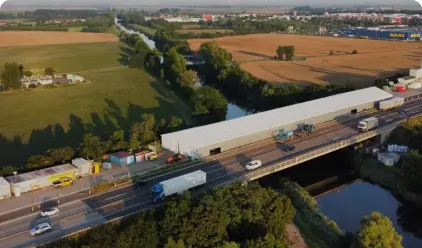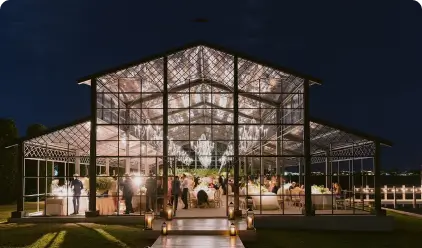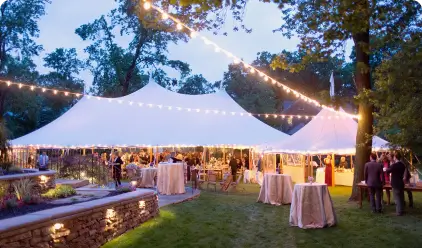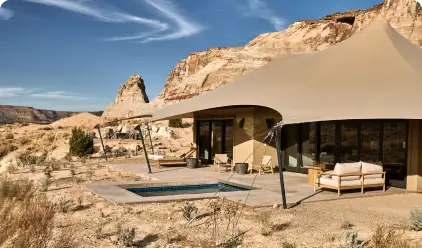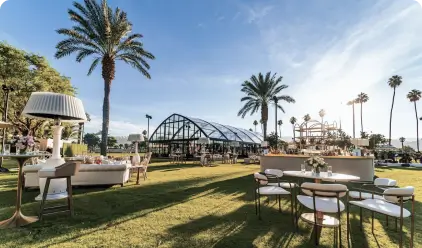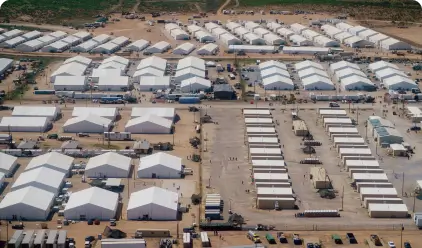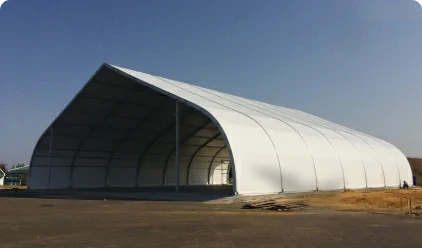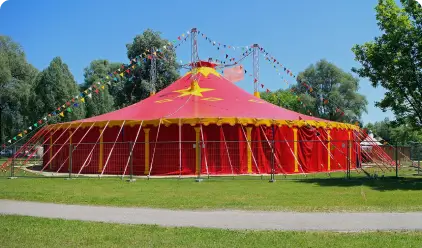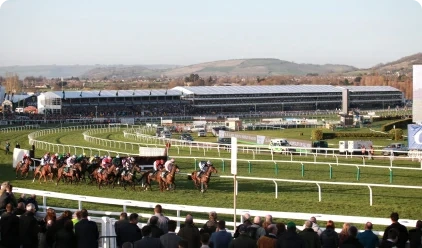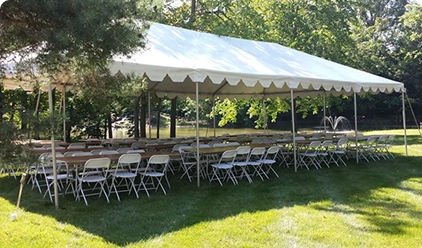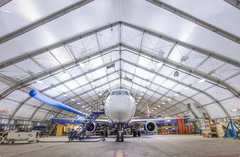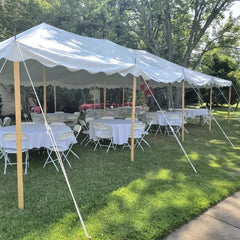10 Questions to Ask When Buying Fabric Buildings
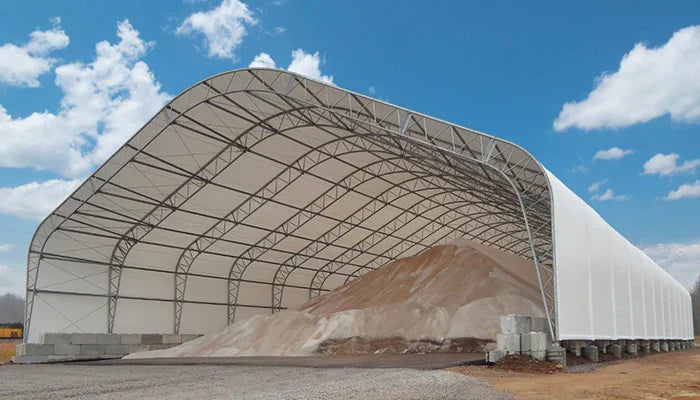
The fabric building is a simple facility composed of two parts, a PVC cover and a metal frame (usually made of sturdy materials like steel, aluminum alloy, etc). These days, they are commonly used as flexible structures to host outdoor activities, store equipment, house livestock, as well as garbage.
However, some concerns would naturally pop up: what factors do I need to consider when choosing a fabric building? How would I know if I had picked the perfect one for my purpose? These are the least things that you should worry about. Here in this blog, we will offer answers to 10 essential questions that one may ask when buying a fabric building.
🎈You May Also Read:
Best Industrial Tent: What to Look for?
Semi Permanent Tent: What Is It & How to Build
10 Crucial Questions to Ask When Buying Fabric Buildings
Before purchasing fabric buildings, you should have a deep understanding of several factors, including the sizes, materials, costs, and customization services... In this part, you'll learn more about the details of the 10 key things about these facilities, so keep on reading.
What Size Do I Need?
Deciding on the actual size of the fabric building is the first step. The right size would be more applicable to the venue and thus reduce the adjustment or replacement cost. Fabric buildings usually have standard sizes that range from small (20' x 20' to 40' x 40' ft) to bigger ones (100' x 100' ft or more).
It is true that there are a few things to consider for the building sizes. The intended use, venue size, and budget are all important factors that influence the choice of the building.
Among them, the intended use should be the top priority. For example, small-sized buildings are usually used for garages or outdoor events, medium-sized ones for light industrial and commercial uses. And for warehouses, temporary factories, and sports centers, the larger ones may be more suitable.
Though there are many sizes that you can choose from for the building, it is not so easy to find one that just perfectly matches your needs. The good thing is that some fabric building manufacturers are ready to customize the sizes of the building for you. So if you are not very sure about the size of the building, you can also check with your supplier and customize the ideal size for your venue.
What Fabric Building Materials Are Available?
Materials used to manufacture fabric buildings are also very important. They determine the service life of these buildings. The more durable the materials are, the longer the lifespan of these structures.
Generally speaking, a reliable fabric building should at least consist of a sturdy metal frame and a waterproof cover so as to function as a weatherproof enclosure for people and items under it.

Though steel is a good material for constructing the framework of the building, more and more manufacturers choose to use aluminum alloy as its raw material due to its lightweight and corrosion resistance. And for the cover, it can be made of PVC, polyester, nylon, etc. But the perfect material would be PVC because it is 100% waterproof.
Almost every fabric building supplied by Sheltent is crafted from an aluminum alloy frame, galvanized steel fasteners, and a PVC cover. These materials make the buildings remain stable in various situations.
How Weather-Resistant Are Fabric Buildings?
Since fabric buildings, like hoop buildings, are located in outdoor settings, you should also take weather resistance into consideration. The strong capability of withstanding harsh weather conditions means that these structures can stand still even in the face of strong winds, rain, or snow. They won't fall down easily or cause any safety concerns.
Some high-quality construction, take the example as Sheltent's fabric buildings, could bear up to 120km/h wind load and 0.5km/m² snow. When you are choosing the right fabric building, try to follow such a criterion, as it may help lower the risk of tearing the membrane due to frame deformation.

Meanwhile, a weather-resistant fabric building also works well to prevent the harm of ultraviolet rays. Most people choose fabric buildings as shelters for their property, or say, assets. This function is particularly important for storage tents, greenhouses, and warehouses. Under these situations, fabric buildings are mainly used to protect the items under them from strong sunlight to avoid further losses.
What's the Building's Anchoring System?
A good fabric building won't be a complete one if there is no solid anchoring system. It helps to firmly secure the structure, allowing it to stand still and serve as a safe shelter. It can be said that those sturdy anchoring kits greatly ensure the flexibility and adaptability of fabric building to various terrains, no matter whether it is grass, concrete, or asphalt.
The key to choosing a building with a well-rounded anchoring system is to focus on the specific ground situation. Normally, there are steel stakes, expansion bolts, as well as tent ballasting anchoring systems on the market. And they are almost the most effective ones to help fasten your fabric building. Each of them functions well on different grounds.
How Much Does a Fabric Building Cost?
Based on specific needs and requirements, the cost of a fabric building may vary. The overall expense depends on factors like sizes, tent materials, and other additional functions, say, electricity or ventilation. Unlike those steel buildings which would cost you at least $34 per square foot, the price of fabric ones is relatively low, usually ranging from $20 to $30 every square foot.
Apart from that, several potential costs may often arise when you are using the fabric building. And you should count on them to make a more reasonable budget plan. They may include labor, maintenance, electricity, and ventilation expenditures. Therefore, the total cost of installing a fabric building would increase to an average of $35 to $50 per square foot.
Can I Heat or Insulate a Fabric Building?
A challenge for fabric building is that it has to struggle with the freezing temperatures during winter days. Therefore, a top-quality fabric structure is often well equipped with insulation layers to reduce heat loss.
In addition, adding a HAVC heating system is also a good way to keep the inner space warm even on the coldest days and nights.
On the coldest days, the minus temperature, along with the howling winds or heavy snows, could pose a threat to the property sheltered under the tent. Especially if you are using the fabric building for planting trees, flowers, and vegetables, you may need to heat the tent with some efficient heaters, such as wood-burning stoves, electric heaters, and propane heaters, or take some insulation measures to isolate heat from the inside.
Can I Customize a Fabric Building?
The fabric building often provides customization services. Generally, the supplier would be happy to make a unique building for you. It allows you to personalize such a structure in terms of its size, shape, application, color, accessories, etc. This is crucial to make the most of the activities.
Fabric buildings nowadays come in a variety of options, but for one that perfectly fits your exact needs, customizing it would be the best solution.

In Sheltent, we offer the most considerate customization service in the industry. Our fabric buildings are highly customizable. You can personalize the floor, lighting system, HAVC, ventilation, as well as materials. In doing this, the functionality, design, and scalability are all leveled up to adapt to different scenarios.
How Long Will the Fabric Building Last?
In most cases, if it is properly used and maintained, a qualified fabric building will last 10 to 20 years. This depends on the way you treat it and the particular weather conditions. If it has long been exposed to strong UV rays, pouring rain, or heavy snow, its service life would be significantly reduced. So installing the building is just the start. You have to do more to expand its lifespan.
When you no longer need it, remember to take it apart and store it carefully. Inspection is also necessary. By doing that, you can find those minor issues early on and promptly repair any punctures or tears in the building.
Anyway, the key point lies in frequent cleaning and maintenance. Through proper application and storage, the lifespan of a fabric building can be easily extended for another two or three years.
Do I Need a Permit for This Fabric Building?
Getting permission is a key step to setting up a fabric building. You have to obey the local rules, laws, and regulations. This requires you to do some research in advance for this fabric structure, as in some countries, there might be some restrictions on its size, shape, and other specifications.
To simplify the process, you can consult the local government or civil department. You may need to prepare documents to state the purpose, activity arrangement, and other relevant details of the event. As long as you get approved by local authorities, the whole project will be more professional and successful.
Can I Move or Expand the Building Later?
Nowadays, fabric buildings are commonly used to host various temporary events that often last for a short time, and you have to change from one place to another frequently. Then you might need to consider whether the tent is convenient for you to move during subsequent use.
Meanwhile, most people don't buy it and use this building only at one single venue. Instead, you would expect it to be highly adaptable to different scenarios and activities.
In this situation, you also need to prioritize the ease of expansion and transportation when buying a fabric building. It allows you to quickly move it to another venue and adjust it to meet different needs. And this will cut down a lot of labor costs.
🎈You May Also Like: What Is A Tension Fabric Building & What to Consider to Buy
Choose the Best Fabric Buildings from Sheltent
It is easy to consider all these key factors, but it can be tricky in the actual selection of the ideal fabric building. A good solution to this is to find a reliable manufacturer from the very start. You don't need to struggle with these questions; you just need to tell them your requirements.
Among so many fabric building manufacturers, the highly recommended one is surely Sheltent. It has been devoted to developing tents for more than 10 years. We can answer all those questions mentioned above, and we have become a top player in this industry.
The fabric building provided by us, especially the A-frame clear span tent, is exceptionally practical. To be specific, we would offer the best customization services based on the size, shape, color, insulating layers, and efficient heating systems, etc.

Meanwhile, the study materials and strong weather resistance capability endow it with a long lifespan and ensure it remains stable in different situations. More surprisingly, it can be expanded and extended freely to suit various purposes. All in all, it is a relatively cost-effective choice that combines almost all of the features that a perfect tent should have.
Conclusion
It is never wrong to think twice before you decide to buy a fabric building. If you haven't chosen the right one yet, try to ask yourself the 10 crucial questions above, as they may offer great assistance in finding a reliable fabric building. As long as you figure out the answers in your mind, you are pretty close to the specific structure you want.
Of course, you can always simplify the procedure of purchasing fabric buildings. That is, find a trustworthy manufacturer. Among so many suppliers, Sheltent stands out from the crowd. It has been selected by numerous global brands as their cooperators. We aim to offer industry-leading services and products to our clients from the day we are established.
If you need a professional fabric building and want some tent advice or technical support, never hesitate to contact us! We won't let you down in giving you the best experience in this industry.




























